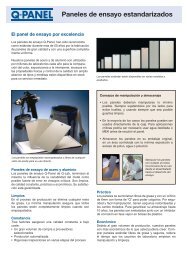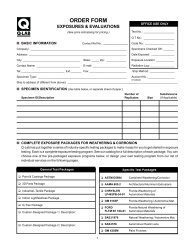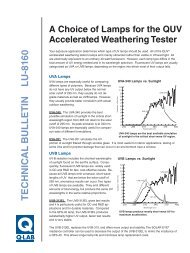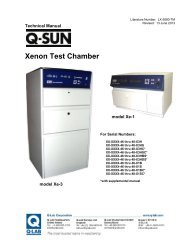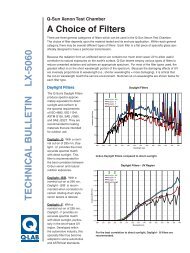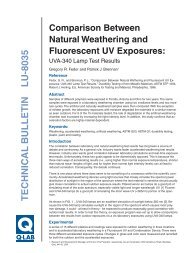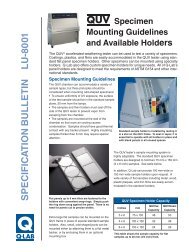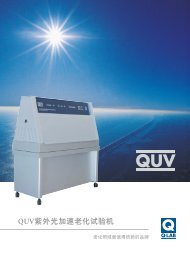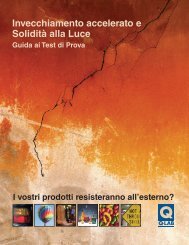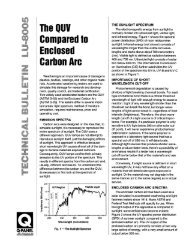LU-8031 - High Irradiance UV Testers - Q-Lab
LU-8031 - High Irradiance UV Testers - Q-Lab
LU-8031 - High Irradiance UV Testers - Q-Lab
You also want an ePaper? Increase the reach of your titles
YUMPU automatically turns print PDFs into web optimized ePapers that Google loves.
Figure 18<br />
Vinyl Gloss Loss<br />
Gloss<br />
100<br />
100<br />
90<br />
80<br />
70<br />
60<br />
50<br />
40<br />
Material: Vinyl Film (blue)<br />
Test Conditions:<br />
30<br />
Q<strong>UV</strong>/se<br />
20 Lamp: <strong>UV</strong>A-340<br />
<strong>Irradiance</strong>: 1.35 & 0.83 W/m2/nm @ 340nm<br />
10 Cycle: <strong>UV</strong> Only<br />
Temperature: B.P. 50C<br />
0<br />
0 500 1000 1500 2000 2500<br />
Figure 19<br />
Urethane Gloss Loss<br />
Gloss<br />
90<br />
80<br />
70<br />
60<br />
50<br />
40<br />
30<br />
20<br />
10<br />
0<br />
Figure 20<br />
11<br />
Hours Q<strong>UV</strong>/se Exposure<br />
Material: Urethane Coating (gray)<br />
100% <strong>UV</strong><br />
<strong>UV</strong> + Moisture<br />
Moisture + Dark/Dry<br />
<strong>UV</strong> + Moisture<br />
<strong>UV</strong> + Dark/Dry<br />
100% <strong>UV</strong><br />
0 500 1000 1500 2000 2500 3000<br />
Hours Q<strong>UV</strong>/se Exposure<br />
Polypropylene Gloss Loss<br />
Moisture + Dark/Dry<br />
<strong>UV</strong> + Dark/Dry<br />
Material: Polypropylene Sheet (natural)<br />
Test Conditions:<br />
Q<strong>UV</strong>/se<br />
Lamp: <strong>UV</strong>A-340<br />
<strong>Irradiance</strong>: 1.35 & 0.83<br />
W/m2/nm @ 340nm<br />
Cycle: <strong>UV</strong> Only<br />
Temperature: B.P. 50C<br />
Exposure Duration & Measurement<br />
Intervals<br />
As a general rule, exposures should be run until<br />
the material has reached complete failure. This<br />
is because the perceived difference in the rate of<br />
degradation between any two exposures may vary,<br />
depending on how the data is analyzed.<br />
Figure 21 shows how running an exposure test<br />
to a predetermined level of degradation (in this<br />
case, yellowing) can cause confusion. If the exposure<br />
had been terminated after a delta b of 8 was<br />
reached, the higher irradiance exposure would<br />
appear to be 48% faster. If the exposure had been<br />
terminated at a delta b of 34, the higher irradiance<br />
test would appear to be only 32% faster. Only running<br />
the test to complete failure shows the true<br />
relationship between the two exposures.<br />
Figure 21<br />
Comparison at Varying Levels of Yellowing<br />
delta b<br />
48<br />
40<br />
32<br />
24<br />
Material: ABS Sheet (white)<br />
delta b = 34<br />
3% faster<br />
0.83<br />
16<br />
Test Conditions:<br />
Q<strong>UV</strong>/se<br />
Lamp: <strong>UV</strong>A-340<br />
8<br />
<strong>Irradiance</strong>: 1.35 & 0.83 W/m2/nm @ 340nm<br />
delta b = 8<br />
Cycle: <strong>UV</strong> Only<br />
4% faster<br />
Temperature: B.P. 50C<br />
0<br />
0 500 1000 1500 2000 2500<br />
Hours Q<strong>UV</strong>/se Exposure<br />
1.3<br />
delta b<br />
9<br />
7<br />
5<br />
3<br />
1<br />
-1<br />
100% <strong>UV</strong><br />
0 1000 2000 3000<br />
Hours Q<strong>UV</strong>/se Exposure<br />
<strong>UV</strong> + Dark/Dry<br />
Test Conditions:<br />
Q<strong>UV</strong>/se<br />
Lamp: <strong>UV</strong>A-340<br />
<strong>Irradiance</strong>: 1.35 & 0.83 W/m2/nm @ 340nm<br />
Cycle: <strong>UV</strong> Only<br />
Temperature: B.P. 50C<br />
<strong>UV</strong> + Moisture<br />
Moisture + Dark/Dry<br />
Figure 22 shows the same data used in the previous<br />
figure. However, here the exposures were<br />
analysed after a predetermined number of hours. If<br />
the two exposures are compared at 500 hours, the<br />
difference appears to be 100%. If they are compared<br />
at 1000 hours, the difference is 22%.<br />
This moisture effect is even more dramatic on the<br />
urethane. Again, although the <strong>UV</strong>+Moisture Cycle<br />
exposed the material to only half the <strong>UV</strong> dosage<br />
as the 100% <strong>UV</strong> Cycle, the rate of degradation is<br />
much faster.<br />
Sometimes the presence of moisture effects both<br />
the rate and the type of degradation. This is illustrated<br />
in Figure 20. In this case, the <strong>UV</strong>+Moisture<br />
Cycle gave a very different result than the cycles<br />
that omitted moisture.



